We Need to Talk about The Dig on Netflix and How it Portrays Women
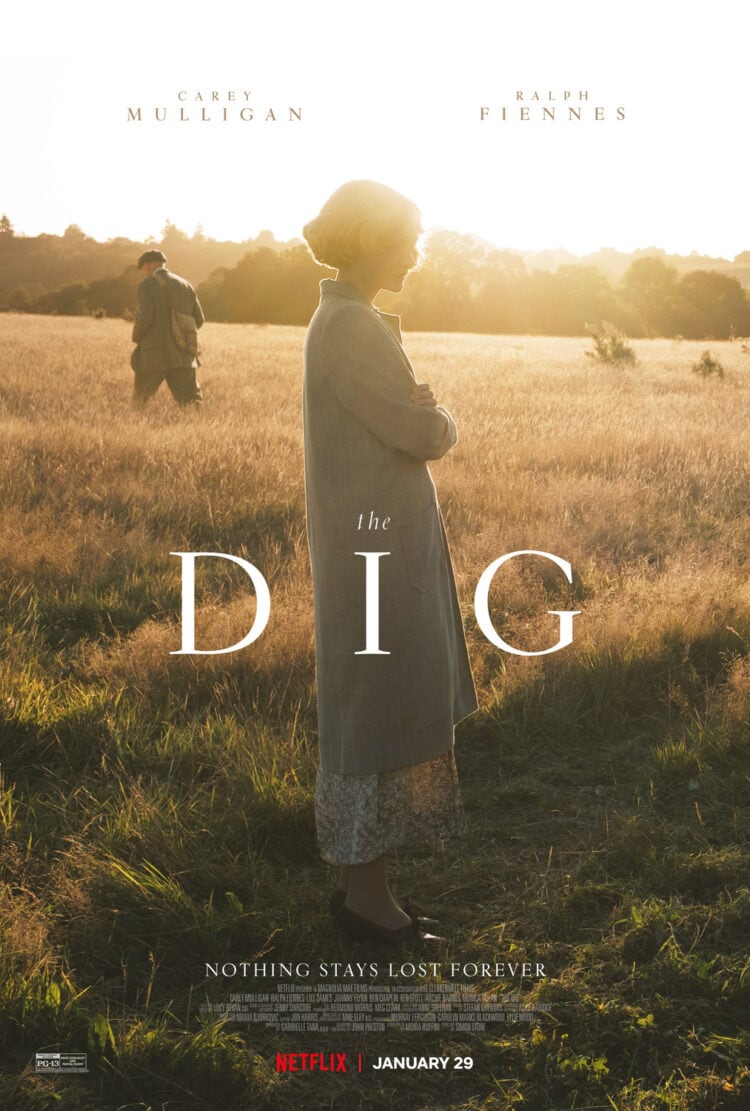
This weekend, my husband and I watched The Dig, a new movie on Netflix that stars Carey Mulligan and Ralph Fiennes. We chose this movie because my husband recently learned about the true story behind this movie. He watched some documentaries and did additional research and had been sharing what he learned with me for weeks. The Dig did NOT share the story either of us was expecting.
Tell me About The Dig on Netflix
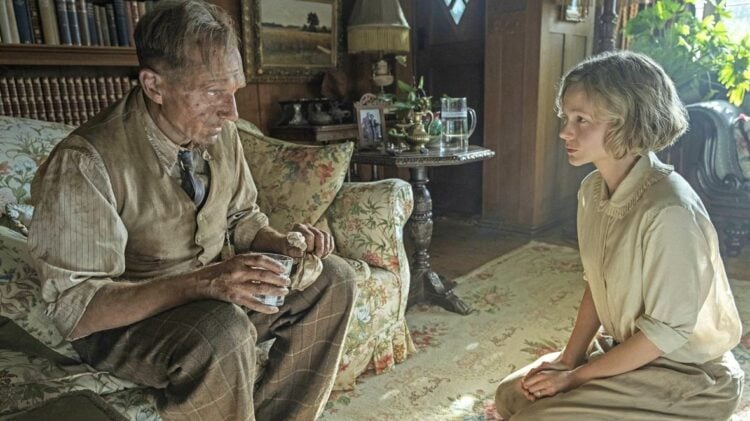
The Dig is based on a 2007 book of the same name by John Preston. Preston’s book is a piece of historical fiction about the Sutton Hoo excavation. Preston was inspired by finding out after her death, that his Aunt Peggy participated in the excavation and found the first piece of treasure at the site.
While this novel is based upon a true story and includes real people, Preston took creative liberties to craft an engaging dramatic book about this event. Nothing wrong with that, some of the best novels are historical fiction. But this book has a lot of inaccuracies and due to it being written by the nephew of Peggy Piggott (one of the excavators), his book focuses a lot on this individual.
While The Dig is a good movie, it missed the opportunity to be a great movie. And that’s because it’s based on this book and not based on the real, and in my opinion, far more fascinating life of Edith Pretty, the owner of the property where the Sutton Hoo excavation took place.
See, Edith Pretty was a badass, and you’d never know it from this movie.
Who was Edith Pretty?
Edith May Dempster was born on August 1, 1883 to society and wealth. Her grandfather was poor but worked his way up to being a factory owner; his son was an incredibly successful industrialist. Edith’s family traveled all over the globe, met royalty and leaders of countries, even participated on historic archeological digs in Egypt and Pompeii. Her father even excavated a Cistercian abbey adjoining their home at Vale Royal. This upbringing made Edith curious and passionate about history and also gave her confidence to follow her dreams.
She went to school at Roedean in Sussex, where she was given the nickname “Dempy”. Edith helped crew racing yachts. She had chauffeurs but preferred to drive herself in an open-top car. She even once flew a plane.
Edith wasn’t just full of adventure, she felt she had a duty to use her wealth and position to help others. When she was 30, she paid for a Mission Hall to be built in Manchester. The next year, Edith became quartermaster of a Red Cross auxiliary hospital. She insisted on traveling to France to work as a nurse with the Red Cross during the war even though everyone warned her not to.
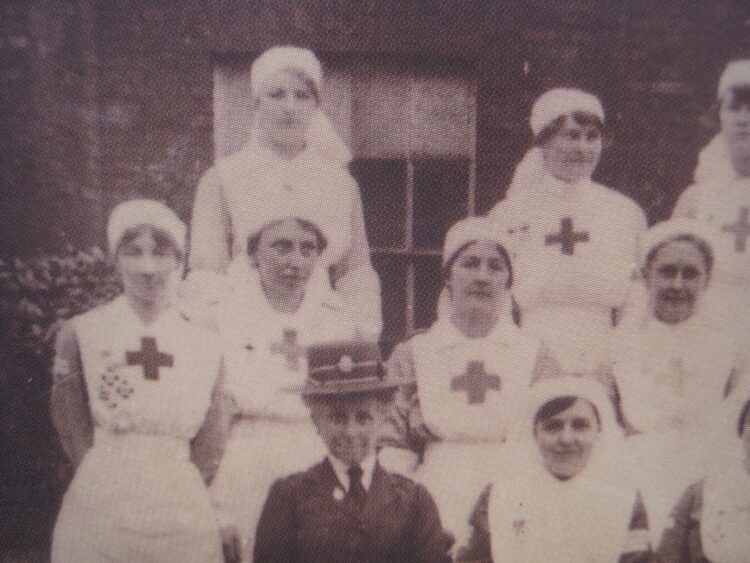
In 1922 at age 36, Edith became one of England’s first women magistrates and was invited to stand for Parliament. She would have become only the third ever female MP but refused, citing responsibilities to her now-widowed father. And speaking of her family obligations…
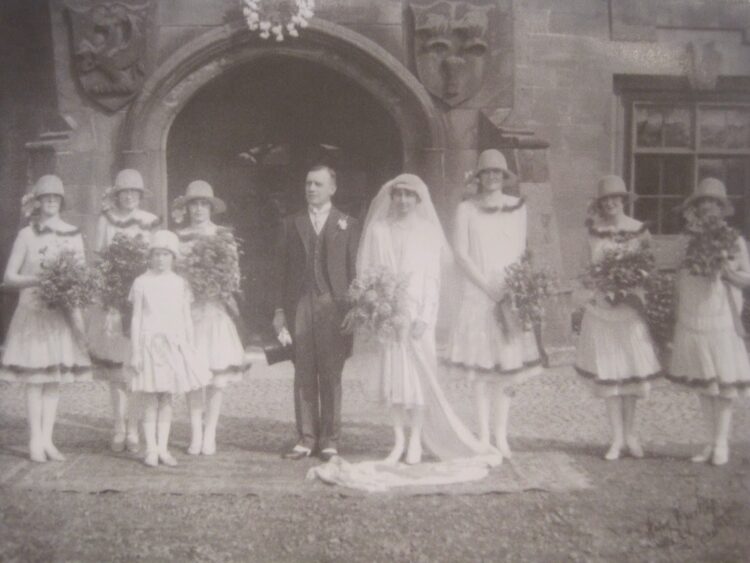
When Edith was 18, Frank Pretty, a brother of one of her school friends proposed. She refused, stating she needed to care for her family. Frank continued to propose to Edith every single year on her birthday. Edith’s mother passed in 1919, her father in 1925. Edith accepted Frank Pretty’s marriage proposal after the passing of both parents.
Some say she waited until after her father's death to marry Frank because her father didn't approve of him. Edith and Frank had a fancy society wedding with 200 guests in 1926. She was 42, her husband 47.
Edith Pretty got pregnant in 1930, she was 47 years old. At the same time she also contracted typhoid, which affected her health for the remainder of her days. Can you imagine being 47 years old and pregnant in 1930? It’s hard enough to be pregnant and 47 in 2021!
And then Edith’s husband got stomach cancer. The doctor told Edith not to tell her husband he was dying. She kept that secret until he died just after Christmas of his 56th year. Their child was only 4.
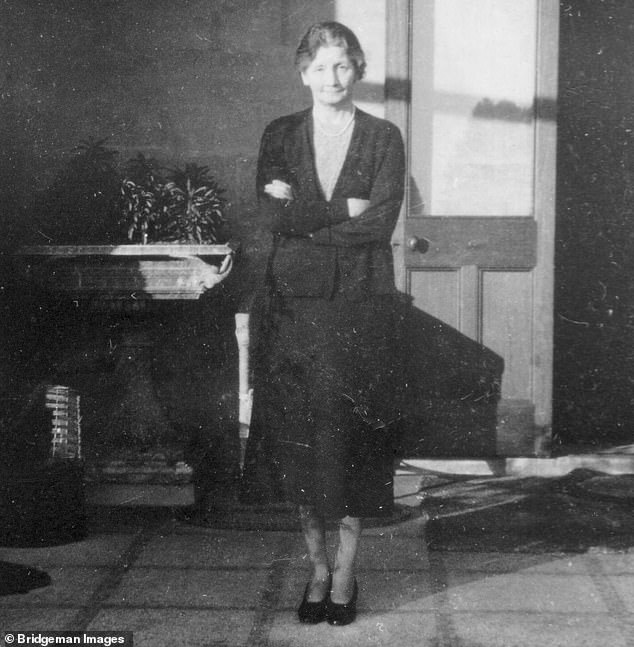
Edith Pretty was into Spiritualism, which was very big during this era. She was known to regularly visit mediums and have them visit her estate. While her husband was ill, Edith had faith healer William Parish visit and felt he helped her husband’s health. After her husband’s death, Edith financially supported Parish and his wife to build a healing house and continue their business. She had a small altar off her husband’s office where she could “communicate” with him after he died.
After her death, one of Edith’s grandsons unearthed a box full of her letters. In one, Winston Churchill offered Edith a CBE to recognize her part in the Sutton Hoo find, which she refused. Many who knew Pretty felt this was typical for this badass who lived life for herself and to serve others, not to impress others.
What is Sutton Hoo?
Sutton Hoo gets its name for residing in the Suffolk village of Sutton. Hoo means hill or raised land overlooking water, and we know by now that the area is famous for the burial mounds. Sutton Hoo is about seven miles from the North Sea and an area that was well-traveled throughout history.
Edith and Frank Pretty bought the Sutton Hoo estate in 1926. One reason Edith desired this estate was because of the unusual burial mounds on the property (remember, she has always been into archeology and history).
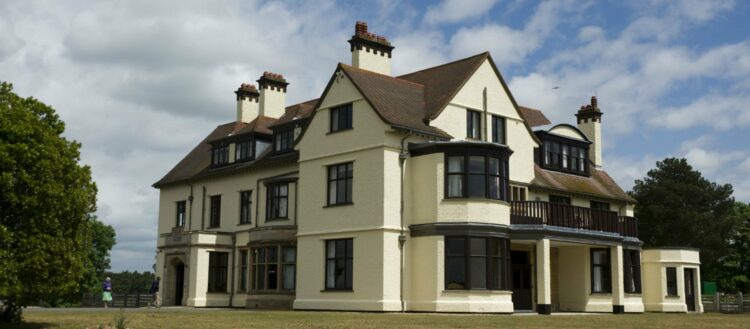
Also, the property had a gorgeous 15-bedroom mansion on it, which was built only a couple of decades prior. This mansion was bequeathed to the National Trust in 1998 and now is called the Tranmer House in honor of the last owners of this home. Not only can you tour, but they also have it set up where you can have an overnight getaway at this estate!
Anyway, back to Edith Pretty and the Sutton Hoo excavation.
In 1937 Edith Pretty decided to have the burial mounds on her property excavated. Many say it was because she had a dream where ghosts came from the mounds, the largest one in particular. She reached out to a local museum that recommended Basil Brown.
Who was Basil Brown?
Basil Brown was born in 1888, five years after Edith Pretty. He was pretty much self-taught. He had astronomy books from his grandfather, a bit of private tutoring, and some drawing classes, but left school at age 12 to help his dad run their family farm. He continued his education through correspondence courses, always having a love of learning. In 1923 he married Dorothy May Oldfield, known as May. The two worked hard but were always struggling financially. This excavation job gave him room and board plus more money per week than he was getting at his previous job.
Edith was passionate about this excavation. She knew she was ill and wanted to have it completed before her death.
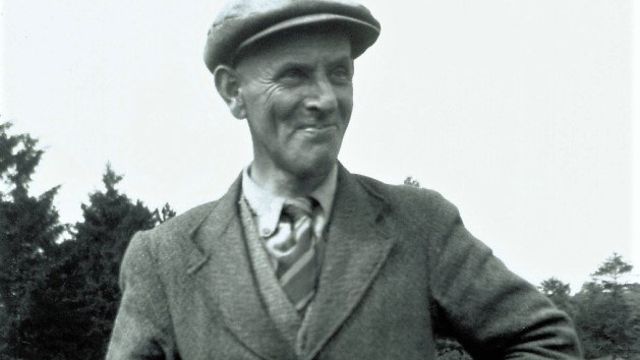
Basil Brown came to Sutton Hoo in 1937. May of 1939, Basil Brown began excavating the largest mound on the property, known as Mound 1. He looked at one the mound and considered that over the centuries the mound could have changed shape. While grave robbers usually excavate from the top down, Basil thought of excavating from the side since he didn’t truly know where the center was located. And because of this genius idea, in July of that same year, he and his team found one of the most important archeological discoveries of all time, helping to define and understand the Anglo-Saxon period.
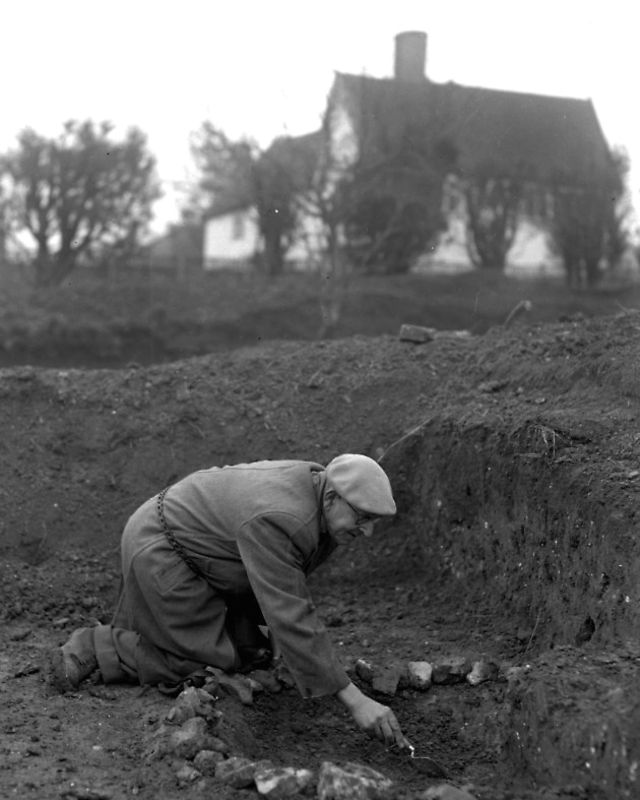
Edith died in 1942 due to a blood clot to the brain which caused a stroke. She was 59. She gifted the entire treasure from the Sutton Hoo excavation to The British Museum, her only request was to ensure Basil Brown was recognized for his part. Yet when the treasure was first shown at the Festival of Britain exhibition in 1951, Brown’s name was not credited.
So What Was Found at Sutton Hoo?
Dude, you need to investigate what was excavated at Sutton Hoo. Sure, the movie shares that there was a big ship (almost 90 feet long) and how impressive it must have been to get it to where it was buried.
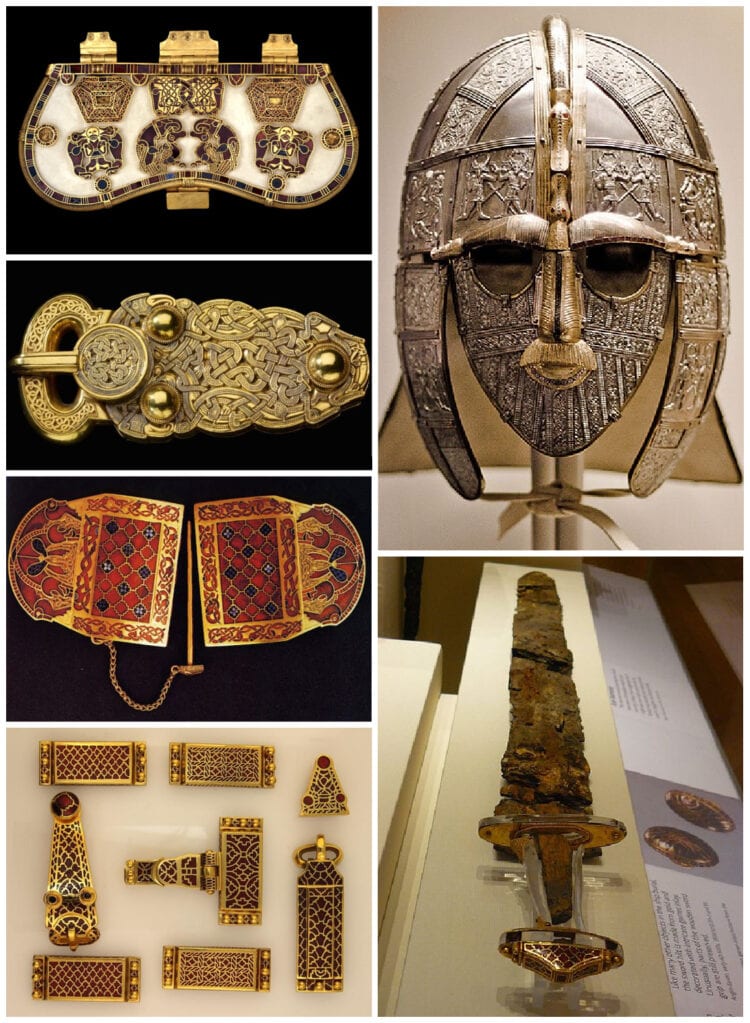
But inside this ship was a priceless treasure and what was clearly the final resting place for an extremely important person from the early Seventh Century. There were Byzantium silverware, garnets from Sri Lanka, and 37 coins from the Anglo-Saxon period before the introduction of an English coinage just to start. Some of the most famous pieces from the Sutton Hoo find are above. A super badass gold belt buckle (second down on left) and a phenomenal helmet (right), one of only four complete Anglo-Saxon helmets to survive, are the most showcased pieces from the treasure trove.
The sword (lower right) is pretty awesome; it was clearly for a left-handed warrior and there has been much research on it and who it possibly belonged to. Seriously, if you don't know about the Sutton Hoo find, it's worth a lunch break Google session.
So, Let’s Get Back to the Movie and How it Represented Women
Okay, let's get back to this movie, The Dig. It was beautiful, it was enjoyable to watch, but it did a major disservice to the real women behind the two primary female characters.
Not only Edith Pretty, Early 20th Century Badass, was misrepresented, but so was Peggy Piggott, the woman who inspired the book that inspired this film.
The Misrepresentation of Edith Pretty
Nicole Kidman, age 53, was to play the part of Edith Pretty but had to pull out of the film due to a scheduling conflict. At the time of this excavation, Edith Pretty was 56, and had almost a decade of poor health. Kidman was replaced by Carey Mulligan, who is 35.
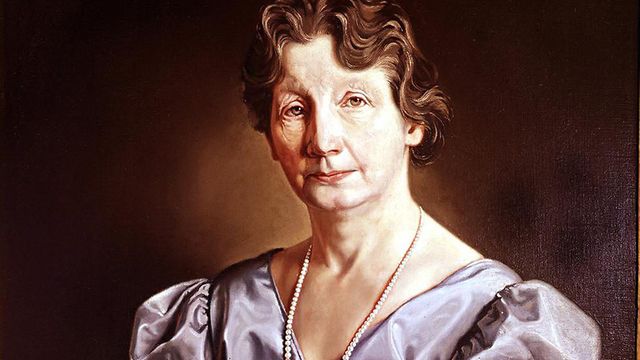
This portrait of Edith Pretty was painted at the same time the dig took place. This is a portrait of a badass woman with means, who didn’t lie down and let life happen to her. She decided when and who to marry, she decided to help during the war even though it was dangerous. She hosted parties for her staff, gave back to her community, no one was her boss. She was a widow with a young child, she had a passion for archeology and followed it. She was strong even though her body wasn’t.
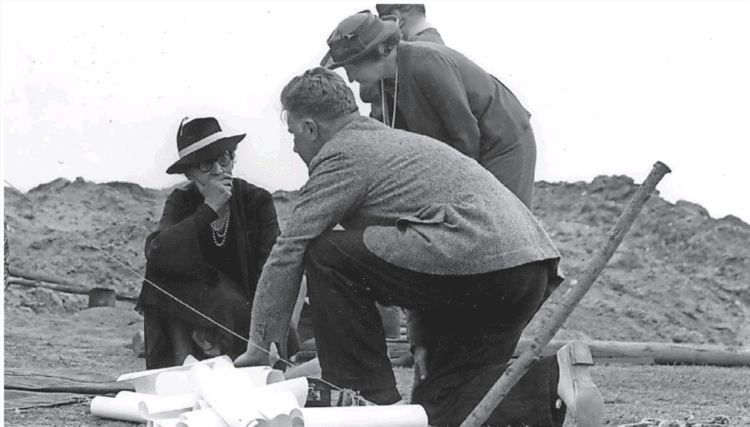
Think how vibrant this film would have been if the character of Edith Pretty was only an iota as vibrant as the real woman. Think how empowering the film would be if they thought to cast a woman that more accurately represented this woman. Imagine the different dynamic of Edith Pretty with the folks from the museums, even her relationship with Basil Brown.
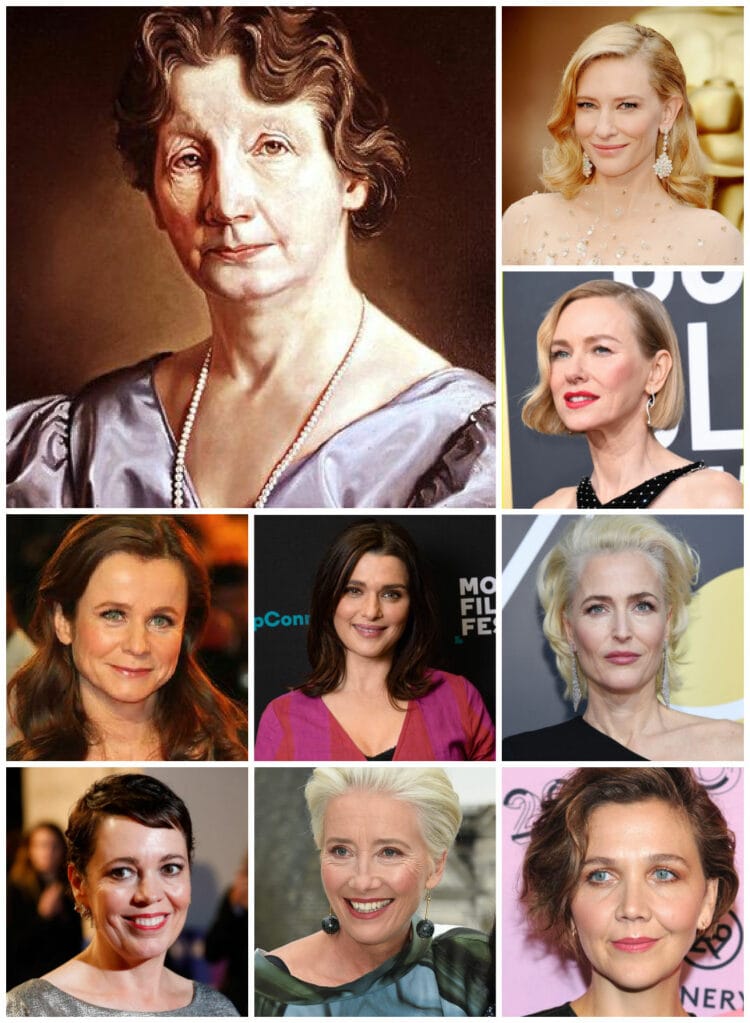
Imagine Emma Thompson (age 60) in the role. Or Olivia Coleman, who is younger (47) but appearance-wise is a better fit while also being a decade older than Carey Mulligan. How about Rachel Weisz who is 50 or Naomi Watts (52)? Gillian Anderson is 52, Emily Watson is 54, Maggie Gyllenhaal is 43, a decade younger than Edith Pretty, but I think would better fit the part than Carey Mulligan.
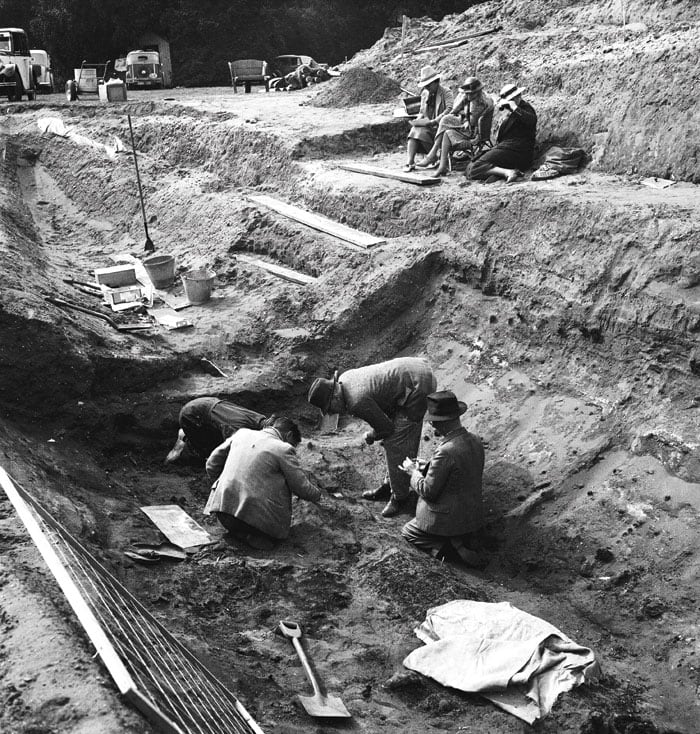
I read in some places that Cate Blanchett was being considered for the role. At 51 and also a phenomenal actress, that would have also been a better choice.
This isn’t a diss on Carey Mulligan, who is a fabulous actress and did a great job in this role. It’s a diss on the film. It’s dissing the fact that not only does this feel like a ‘90s Oscar contender with the sweeping landscapes and score and a long, slow, yet beautiful film but it’s like a ‘90s film by assuming we need a young and pretty lead actress for a film to have any commercial success.
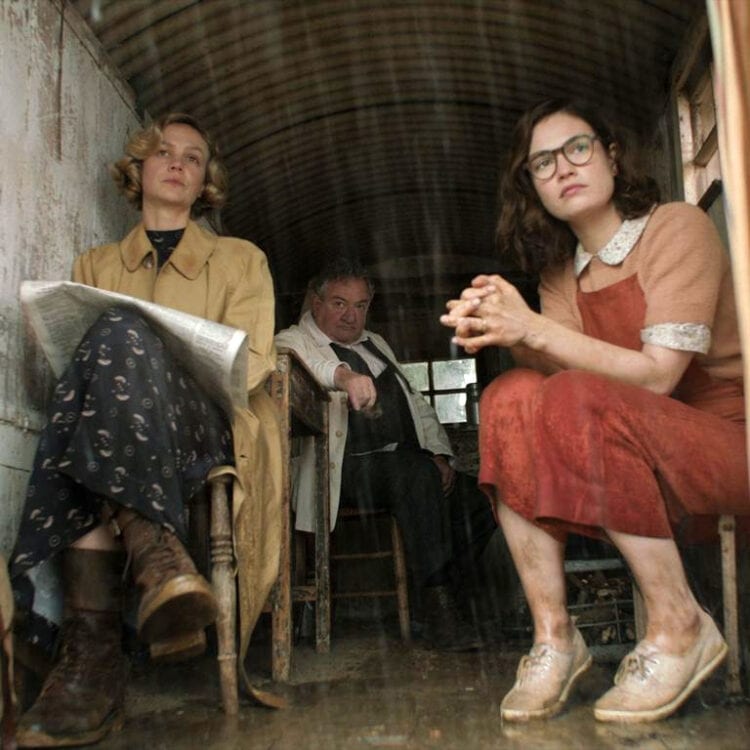
The Misrepresentation of Peggy Piggott
I could also go forever about the misrepresentation of Peggy Piggott, a well-respected archeologist portrayed in the film by Lily James. Known later in her archeological career as Margaret Guido, in The Dig, Peggy and her husband come to be part of the excavation and she is hurt to find she was brought on not because of her expertise, but because she is petite and can work on parts of the dig without damaging it. In the film, Peggy is seen often as a burden, or unnecessary, and the film shows how they found the treasure because she stepped on the cavern, breaking it open by getting her foot caught in it.
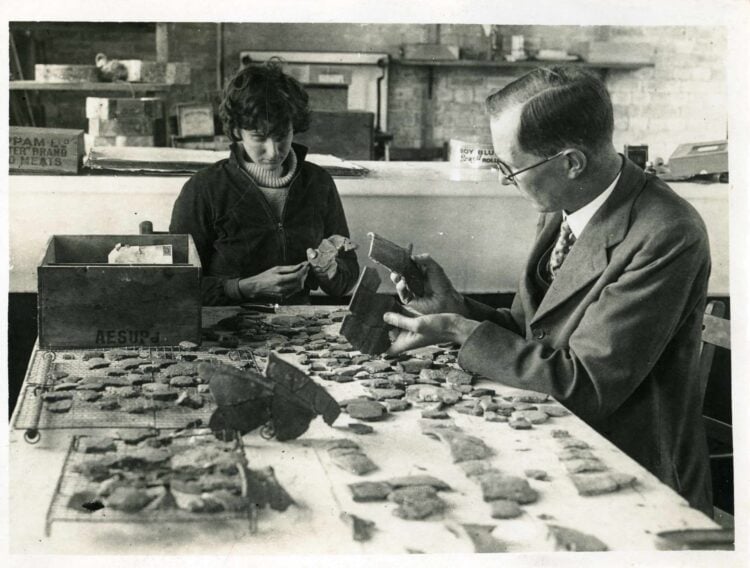
While Peggy Piggott was only 27 at the time of the Sutton Hoo excavation, she had multiple degrees from Cambridge and the Institute of Archaeology in London. She had participated and led many excavations prior to Sutton Hoo, and was an expert on The Bronze Age.
We never learn any of this. Instead, any part of the film showing Peggy Piggott showed her as young and passionate, in an unsatisfying marriage and drawn to another person (a fictional role made up for the story), her priorities seem to be about anything other than Sutton Hoo.
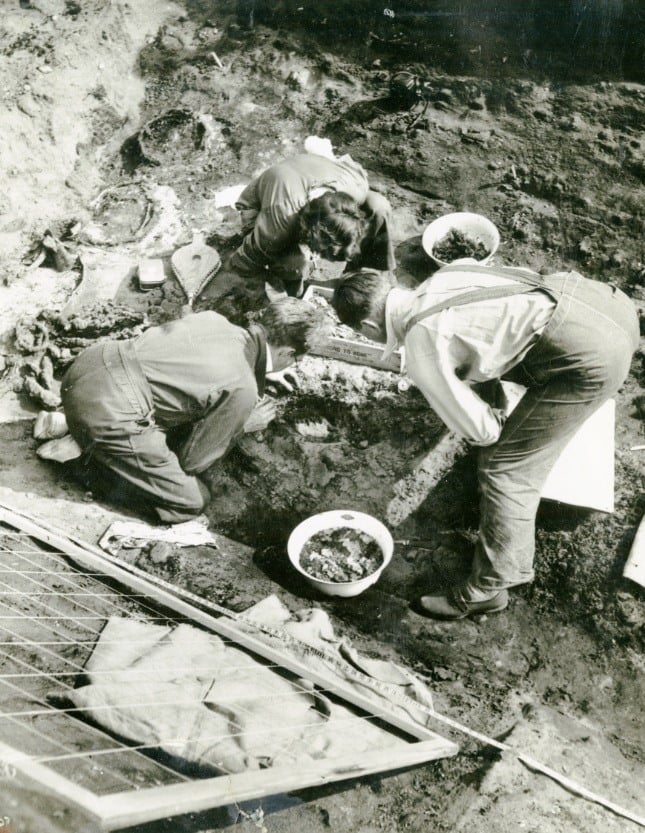
We also see her for a portion of the film in shorts and skin-baring outfits, supposedly because she and her husband came directly from their honeymoon and she had nothing else to wear until Edith Pretty offers her some of her own clothes. This is also fictional.
Not until learning that the author of the novel The Dig was related to her, I couldn’t understand why her role was in the film at all, except to again appeal to ‘90s-era moviegoers wanting a bit of romance for their Date Night event.
It's 2021 and We Deserve Better
This wasn’t a bad film. It was beautiful and not stressful, and all the actors did a fantastic job. It felt like a spa day after the drama of the world news and after seeing so many action-packed shows and movies in recent weeks.
But The Dig missed an amazing opportunity to highlight strong, intelligent, bold women. And in 2021, that is the kind of movie content we’re craving and deserve.
To Learn More About The People Portrayed in the film The Dig
If you'd like to learn more about the real people portrayed in the Netflix film, The Dig, here are some cool articles I enjoyed:
- East Anglian Daily Times: My Friendship with Sutton Hoo's Basil Brown
- ArchMusicMan: Mrs. Pretty and Sutton Hoo (written by one of Pretty's relatives with tons of family photos)
- The Argus: Netflix film The Dig tells Story of Former Brighton Schoolgirl Edith Pretty (written from the perspective of Roedean School, where Edith Pretty attended)
- The British Museum: The Anglo-Saxon Ship Burial at Sutton Hoo (an overview of the history, details on the treasure, and some photos from the dig)
- YouTube: Edith Pretty of Sutton Hoo – the true story by Oliver Gerrish (a relative that shares plenty of photos and stories of Edith's family history and her childhood)

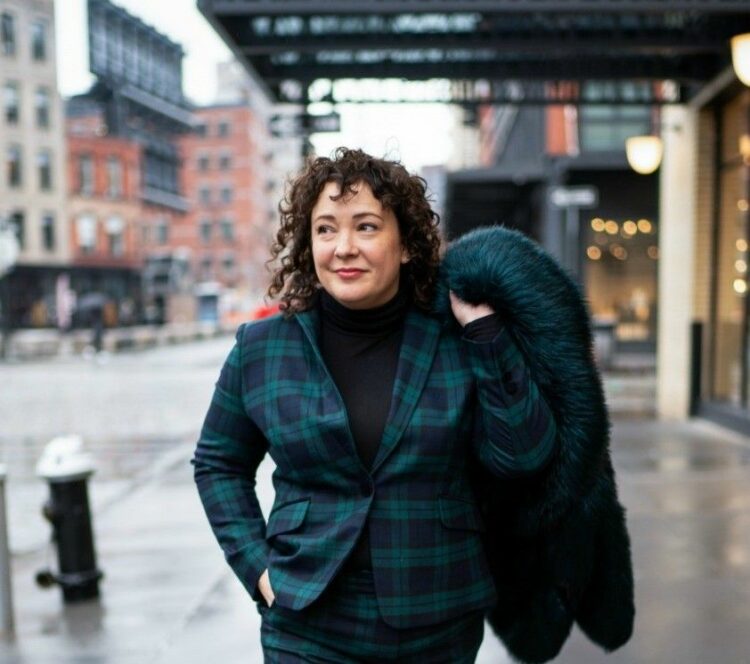
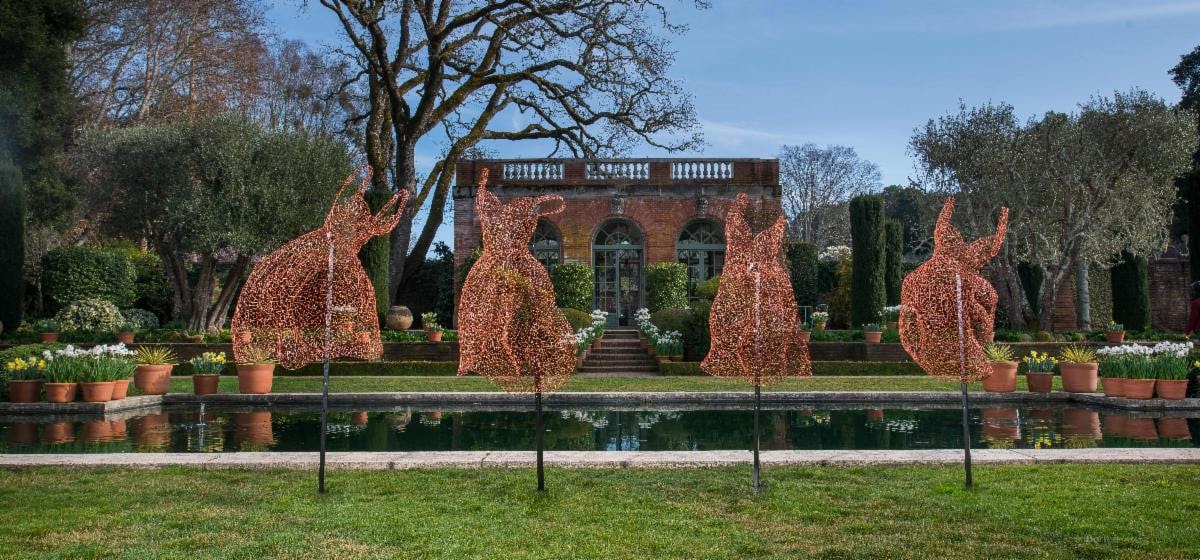
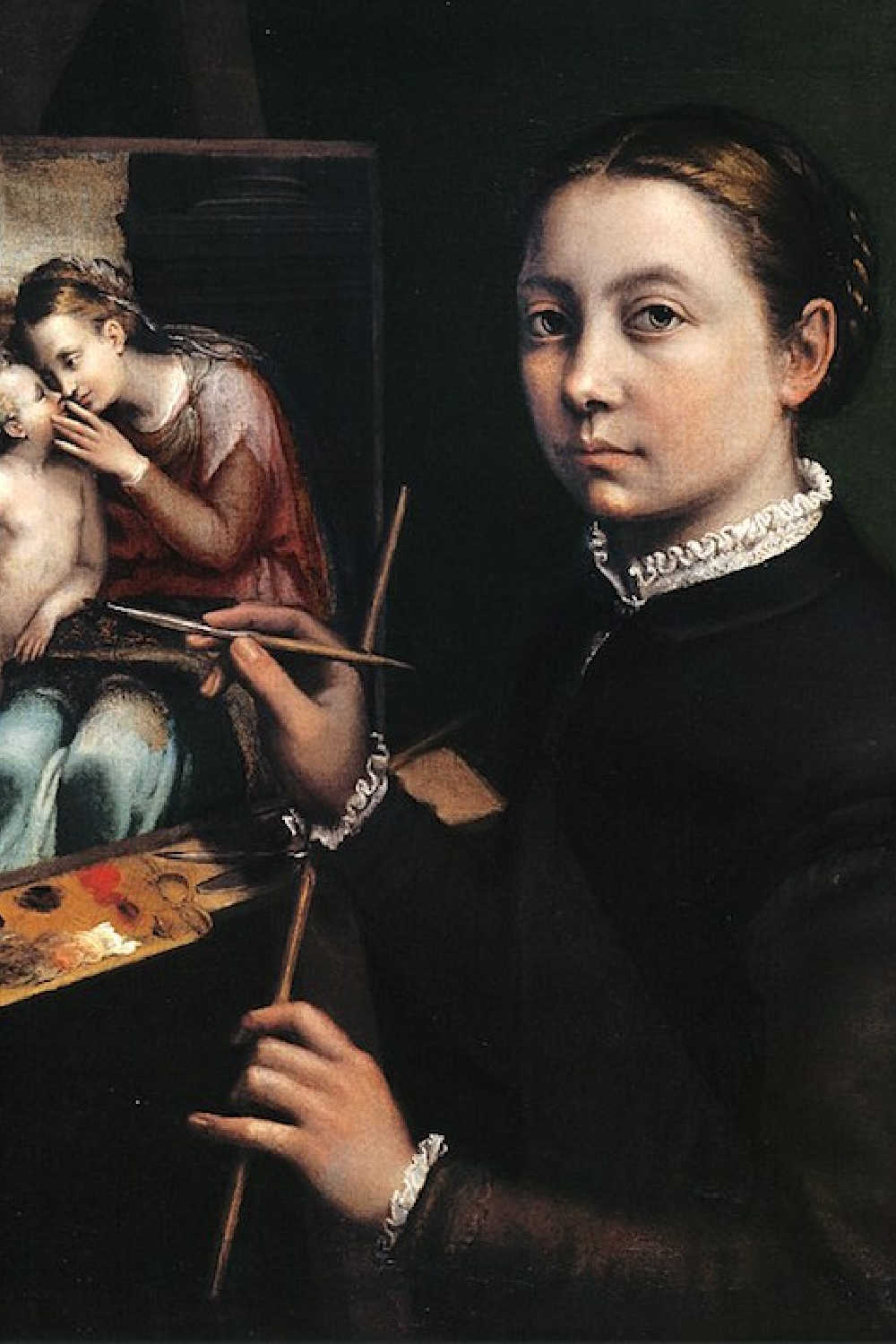


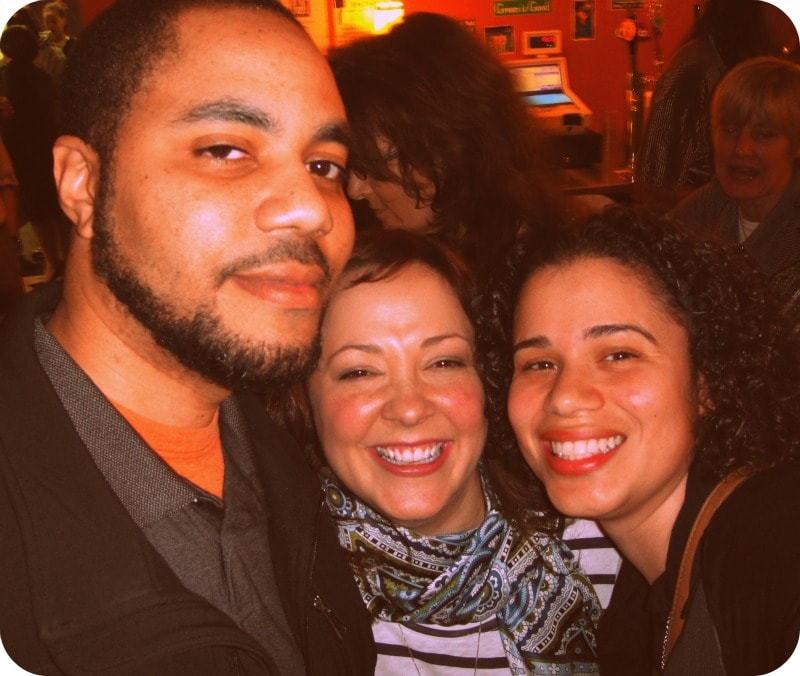
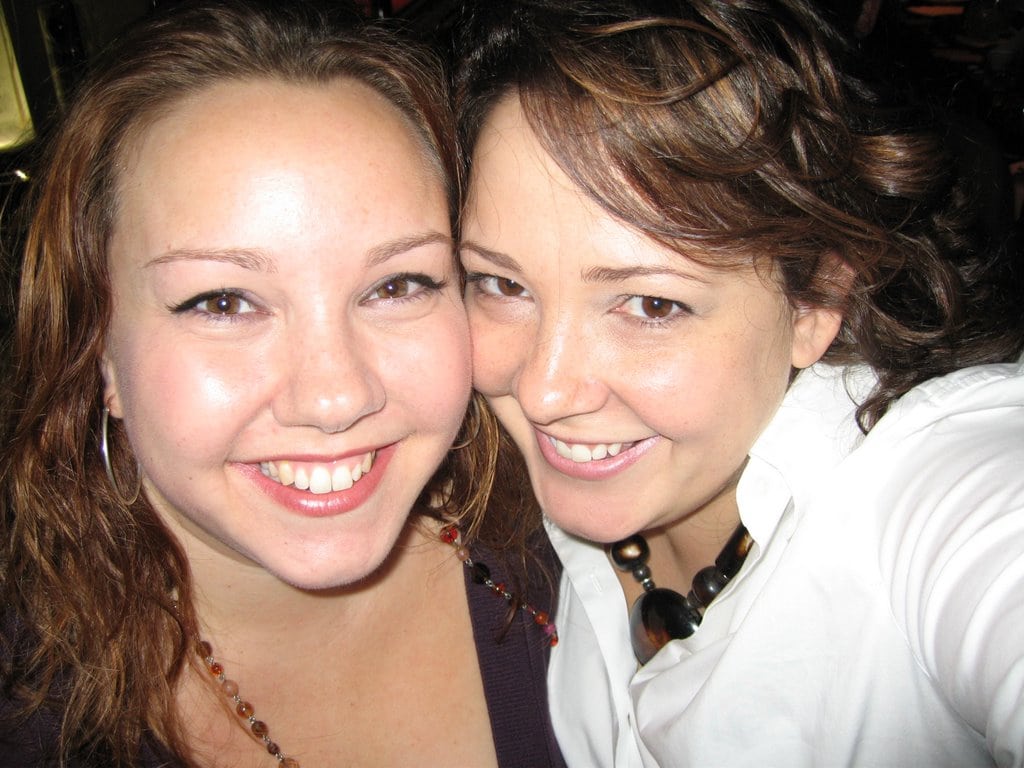
I just watched the film and am so terribly disappointed. Heartsick. The author of the book upon which the film was based, wrote out the two women who photographed the project. Then the screenwriters amplified the author’s erasure, writing out the women of the dig in ways already described. It’s ironic that the author and filmmakers wrote Brown back into history and wrote women out.
The National Trust identifies those who worked on the original dig: https://www.nationaltrust.org.uk/sutton-hoo/features/digging-the-dirt-the-true-story-behind-the-dig
Thank you for this fab article. It makes my irate heart sing instead of scream to know that I have such good company. My Friday-night “covid-eo” group split on what to co-watch recently; one of us wouldn’t watch THE DIG because she’d heard that Mrs. Pretty was portrayed by an actress so much younger than Mrs. Pretty. I’m sending her this post and other links to good info about the dig/discovery beyond the excellent links you’ve already supplied.
I haven’t read all the comments here but wish to add in case it hasn’t yet been added that the male photographer in the film stood in for the two female photographers who documented the dig in real life. Ugh.
But again about Mrs. Pretty: is there something about the interesting interiority and modesty of some super-effective women that stifles the imagination of filmmakers? I think this story could use a complete redo — the dig portrayal, which I loved, and perhaps keeping Ralph Fiennes, who did a fabulous job. Wouldn’t that be great?! Again, loved your article and its tone. Badass forever!
Just finished watching this WONDERFUL movie, in spite of its shortcomings. And it was very positively deja vu!!
My husband and I also bought land, but in Southwest Colorado specifically because it had two large “Anasazi” aka Ancient Ones, room blocks on it–covered in dirt. We wanted to protect it all and learn about it. We put up fence around three sides that were without fences, because the two room block areas were systematically being destroyed by those who thought it was fine to destroy in search of artifacts to sell.
And by the way, my husband and I had a lifelong passion for archaeology, and happened to meet on a dig in Arizona being excavated by the University of Arizona. After we got married, we also participated in several more official digs and excavations before we purchased this land. We knew a lot about the process of excavations. We weren’t green about excavations, in spite of not being “degreed” archaeologists.
We then allowed a local college to have two student field schools, one summer after the other. It was all a part of a plan we had for this property and the ruins which we deeply valued, just like Edith Pretty did. It was thrilling to see what was under the dirt mounds—all sorts of rooms, some pottery, burned pieces, a few kivas, some evidence of burials, and so much more. And it was all a part of a plan we had for this property.
But this wonderful movie also brought up some negatives with our own experience. We found the head archaeologist, and especially his assistant, a to be the height of condescending since we weren’t “degreed” archaeologists–very similar to how the movie portrayed the treatment of self-taught Suffolk archaeologist Basil Brown. There are SO many details and examples I could give here, and to which these condescending archaeologists are, to this day, so very blind and defensive about.
But I digress, because all in all, we are so proud of what we did to stop the plundering, secure the site, and hire a professional, in spite of themselves. The good parts of what we did for that site will always be a proud memory. (We had to stop the process due to my husband’s Agent Orange health issues and his need for better health care.)
Thank you, Alison, for such an insightful, informed and detailed look at this movie and the history it is attempting to portray. This is why I’ve been a fan of yours for so long and will continue to be. I love that you aren’t dissing the movie; everyone involved put a lot of work and love into making what seems like a good film. I agree that it sounds like it could have been so much better if they left out the contrived drama and used the real story instead. Badass women should be celebrated as is, not enhanced to make a “better” story. And why didn’t they show that fabulous treasure?! They easily could have shown images during the credits of some of the best finds after they had been cleaned up and reassembled. I still plan to watch the movie when I get a chance, but it will be better now that I know more about the truth of the events.
Thank you for this wonderful article! I just watched the film and was fascinated by Edith’s character so decided to look her up and was aghast to realise that she has been played by a woman much younger than she actually was at the time of the dig. It might seem like a small detail, but as a 27 year old woman, it really matters to me that a woman at that time was boldly upturning conventions – that she married when she wanted to, had a child when she wanted to and lived a wonderfully exciting life on her own terms. Even today, we struggle against the timelines built for us and are told too often, you must be married by this age and have a family by this age, and so much of that is rooted in history, as if that is ‘what has always been’. Stories about women like Edith tell us that isn’t so – she was resisting against that timeline a century ago! These stories matter and should certainly be told more responsibly. Thank you for highlighting this through your article.
Thank you for the interesting write-up! I hadn’t heard of this film before, but remember learning about this in school.
Just as a side note, sometimes you write Edith’s surname as Petty, & other times as Pretty. I know it’s not a big deal, so feel free to ignore this, but it gave me a little chuckle considering your argument of casting ‘pretty’ women 😉
Could not agree more with your reflections!! .Just now finished watching The Dig after looking forward to it for months and could. It agree more with your thoughts esp regards the interesting life of Edith Pretty before the find. What a wasted opportunity this patriarchal hodge podge is, on so many grounds. It should have remained focused on the real story – Basil, Edith and the find. We’re only “told” about the amazing artistry of the artefacts found when we could have been shown ! Take a look online, the sword is incredible, And the ghastly storyline of Peggy and the photographer, totally unnecessary and ruined the beautiful moment with Edith and her son Robert . A stellar cast totally wasted and the baleful tone overlaying what would have been an exciting and emotional discovery, even at the time with the threat of war looming. So disappointed!!
PS thanks for such a thoughtful and intelligent review. Love how you are evolving your brand!
It is a big deal so I thank you for this head’s up! I have a friend with the last name Petty and likely had them in my head! Updated!
Interesting and intriguing read. I enjoyed Watching The Dig but I do wish that we could get over romanticizing females in movies. Also I felt it was awful that both of these women were diminished by setting them off to the side while the “real work” was being done. Excellent job Alison & Karl. Appreciate your words & your research.
I am so sick of PC outrage over every little thing ruining the beauty in life. Carey Mulligan is a talented actress and a beautiful one too. Why can’t we have good things? Why can’t we enjoy the beauty why do we have to worry about the age of the actress? How is this sexism? The film cast beautiful and talented actresses it isn’t as though they were replaced by men.
You completely missed the point. Typical Calvin. Perhaps reread the article, then reread your response. Why can’t we appreciate the beauty in realism? The strength and intelligence of the women on which these characters are based? Whether or not we convince ourselves otherwise, it is a disappointment to find that the true story behind a film was not quite what was represented. Basil Brown wasn’t recast as a young, attractive, powerful man, and Ralph Fiennes was exemplary. These ladies deserved the same respect, not just by who was chosen to represent them, but by how they were portrayed within the plot. It is good and right to hear their true stories. Reevaluate your opinions, or lump it.
Laura, you know, people who invest in movies want to sell them. And people go to movies and want to see attractiveness. You’re welcome to invest millions of dollars from your pocket and cast unattractive people in your movie. Don’t lecture others about it, just do it and tell us about the results.
Calvin, women need allies and prospective allies may need help in becoming allies. Carey M. did a great job in her role. AND… the role deserved a woman of Mrs. Pretty’s age. In fact the actual dig’s photographers were women and they were replaced by men. Was this reflective of the historical novel on which the Netflix film is based? I don’t know but I’d guess so. I appreciate that you want to be free of the bonds of PCness. People want to be free of bonds. I don’t think that there’s got to be a zero sum game here — either people who want accuracy in the portrayal of women win, or people who are feeling beleaguered by PCness win. Let’s find a win-win that folds in everybody. Except terrible evil doers. They need their own rehab.
It’s funny how women don’t complain about historical make figures being way hotter in movies than they were in real life. Everyone wants a hot actor, a Collin Firth, not some balding, short, fat actor to play a historical figure who was bald and fat. No complaints from women about the lack of accuracy.
*male
You captured perfectly my thoughts about the movie. Thank you for your important voice. For those who say they are no longer interested in watching it, it’s well worth seeing especially when armed with the more complete research here.
I do not enjoy this Era where first world countries cry over their first world problems so much. If you need a movie to be historically accurate then pick up a book or watch a documentary, not a drama film based on the event that peaks your interest in researching for yourself the truth behind the film. As for the age, grow up if 35 can not portray a 56 year old. I actually find Mrs. Pretty quite energetic and youthful and would never guess her actual age from her pictures.
Thank you! Finally a sane person here. Soon people will be offended that Lion King was not voiced by an actual lion.
I thoroughly enjoyed this movie. I don’t care that the lead actress was 35 years old though. This wasn’t a biography, it’s a based on true events. Movies are to entertain, not inform. Even if Kidman had portrayed the role, she doesn’t look 53. You pick actors that will fo the best job for the picture. Enough with the whiny complaints about every thing about every movie
Thank you so much for sharing this information! I, too, love these actresses but the portrayal of the women could have been sooo much better. And yes to employing actresses that are the right age for the part! I hope in the future this story is retold as a limited series. I can imagine this whole story being told over 7 or 8 one hour episodes.
Thank you so much for this! This is what sets you way apart from other influencers. BRAVO
If you’re interested in Suffolk archeology you might want to watch The Dectectorists. It’s funny and sharp and British humour at its best. Not sure if you can get it in the US. Set in Essex but actually filmed in Suffolk.
Thank you for this. I watched the movie over the weekend, and I enjoyed it. But I also found it somewhat unsatisfying. Just as you said, I found Peggy’s unsatisfying marriage just something they threw in for romantic interest, and it didn’t add anything to the film for me. And I knew NOTHING about the real story behind the dog….the women, the actual finds. It was a good movie, but now I see how it could have been so much more. I think having a couple of real badass women, true historical figures in their own rights, would have made this film really come alive.
Thank you for the resources. I was eager to learn more about Sutton Hoo after seeing The Dig. Now I am even more inspired to learn.
As a 65 year old woman, I appreciate this so much. And yet, even you were coming up with very glamourous younger women to cast in the role. Older women have to be physically exceptional in some way to be considered relevant. Usually, it’s a former actress or model who has aged, but is of course still slim and beautiful. And ALL women must be “f*ckable” in some way. Hence the skimpy clothing and dumbing down of powerful women. Remember Amy Schumer’s skit about women having their last f*ckable day? https://www.popsugar.com/love/Amy-Schumer-Last-Fuckable-Day-Skit-37325332
Nicole Kidman must have a great agent. She’s in everything these days. I read the book which her recent series, The Undoing, was based. The main character was described as someone who was unhappy with her short legs, and was known for not caring about her clothes or looks. Casting’s response: Get me Nicole Kidman! LOLOL.
This is a fabulous review and the background is fascinating. Thanks so much!
The industry gotta sell movies. In truth, no one wants to go to a theater as see some basic everyday person on screen. Imagine acne, cellulite, balding, old, fat or disproportionate face on a big screen. Who would pay to see that? We see that around us every day and some of us even in the mirror. People want to see beautiful people and imagine themselves to be beautiful and successful and rest from everyday problems. And Nicole Kidman is one of the last great actresses of the golden era. People will pay to see her because she reminds them of their youth, she is a household name, one that at least three generations recognise around the world. That’s very rare these days and no one will achieve this stardom again because of demystification of Hollywood. Would people rather pay to see a dear beautiful face familiar for decades or some short legged badly dressed actress who is an accurate casting choice?
Sofia that is standard argument and yet we see older, not very attractive men like Gene Hackman have long careers. Also, in Europe, women and men age and still do quite well in film. Men age, gain weight, and are still seen as love interest or male lead. I find your comment sad.
So interesting! Thanks for sharing and the links to the additional articles!
Wow! This was a fantastic and thoughtful post on an unexpected topic. Thanks for this content and your thoughts. We need to demand more in terms of appropriate representation of women and history (including in historical fiction).
Alison, thank you for the very interesting and enlightening post! I had heard about the film and it sounded really interesting, but it also appears that the REAL story was even better! I am so appreciative of your thoughts and the links for us to check out–thank you! I am also grateful for the scope and depth of your writing across a wide variety of subjects so THANK YOU! 🙂
I visited Sutton Hoo several years ago. I couldn’t believe the film didn’t showcase the spectacular finds, especially the helmet! The visitor center onsite told about Pretty’s visions of a silver man or something–would have made a great plot point. Someone will make a documentary about his woman soon, I hope!
They don’t show the finds? Darn it. Well, I guess I’ll still watch it, since its free on netflix.
I think we should put together a Wardrobe Oxygen consortium and make that documentary lol
Just a few of the small objects, none of the major ones. So strange!
Reading the comments after posting my own, I see that my namesake Leah and I are on the same page. A complete redo! But Leah, what about a redo that isn’t a straight doc but rather a much better / more accurate / more compelling recreation and biopic? The same scene and scenery for the dig itself, maybe even casting Ralph F. again (he was great), but true to history and much more compelling, with of course a richer look at and inside the mind and heart and life of Mrs. Pretty. And the discoveries. The true story deserves a just treatment — fictionalized only in the sense of being brought to life.
Actually, the omission of the helmet was one of the things that was historically accurate! The helmet was in pieces when it was found and the excavators didn’t realise what they had. It wasn’t put together again until a few years later, long after the events depicted in the film. I do think though that a little more attention could have been given to the finds, possibly as an appendix at the end of the film. I have seen them many times and they are magnificent.
Good to know. I agree about the appendix!
Alison, usually you and I are on the same page as far as issues concerning women, more accurate representation in the media etc. But not knowing much at all about Sutton Hoo before watching this movie I found the film very enjoyable and so evocative of an earlier time. This is not the first time, nor will it be the last where film makers (and the authors of the source material) simplify, prettify or in other ways change the nitty gritty of reality. The facts are there, as you know…anyone who is intrigued in the archeological background can further investigate to get the real story…the film is not a documentary although I would be very interested to watch that as well! It’s so easy to harp on ‘misrepresentation’ when you have knowledge of the real story…as a physician I often grumble at how the medical world is represented by media. Maybe I’m protesting your view overmuch, but as a retired 68 year old professional woman I was pleased to see talented, thoughtful successful women portrayed respectfully, with perhaps somewhat less well-known actresses, even though I see your point about ages. So sorry to carry on Alison, not sure why I felt so personally demeaned by your opinion this time. Guess I’m going to watch the movie again, just for the feels. Respectfully, D.
I think Alison is expressing disappointment at yet another missed opportunity. And in this case, really two big missed opportunities. We can do better and we don’t. It’s great that you enjoyed the movies, but think of how much better they could’ve been and how much more inspiring they could’ve been, esp. to our younger generations of women.
We can do better? WE? Do you have a stake at a movie production company? Once your own money is on the line I bet you would run after a casting choice that would bring in the most revenue. It’s easy to just talk.
Thank you for that review. How disappointing, especially since I just saw Carey Mulligan in Promising Young Woman, and she was fantastic in it. I think I may give The Dig a miss, now.
Actually, I think Carey Mulligan was excellent. She is an actor and it is her job to portray different characters. She played a strong woman who was mostly in control and knew exactly what she wanted. See her also in Far from the Madding Crowd – truly excellent.
Thanks for this. I am a historian and while it isn’t my field of expertise, I am very interested in the early Anglo Saxon era. When I heard that a movie about the Sutton Hoo hoard was being made, I was so excited. When I saw the trailer, I was apprehensive, mainly based on the use of Carey Mulligan and because it looked like there was a forced love story in there. I’ll still watch it, but I appreciate your post so much. There are so many instances of baddass women out there and I hate when they are watered down for public consumption.
Two more thoughts: you’re a very good historical writer, and YES Emma Thompson would have been perfect in this role.
I really enjoyed your writing and sharing your research and opinions with us. I’m so glad I follow your posts. Fascinating articles and respect for women ; a perfect pairing! Thank you for your hard work and talent.
What a great read. I’ve watched the film and thought much as you did – enjoyable watch, beautifully shot and well acted, BUT….grossly misrepresented the facts PLUS missed a great opportunity . I too have researched a great deal into Sutton Hoo, but not as much as you Alison, and I commend you for your academic approach and attention to detail. Love the old photos too. Well done you. We need more articles like this on the media and the way plots and scripts are skewed to make a ‘better’ story. What rubbish. The real women and their stories are more fascinating,
Thank you for an incredible review and real background history of “The Dig”. I too watched this movie on the weekend and took it at face value, pleasant and loved the history of it. My parents , I thought were the same age as World War 2 was beginning and my oldest brother about the same age as her young son. A window into the time period when they were young. Didn’t suspect Ageism.
Both women were so ahead of their time and to portray them as younger, less educated, way less experienced and historically incorrect is insulting.
I love everything about this post. Thank you for the great in-depth info and the opportunity for further reading. You rock, Alison.
This is one of my favorite sites. Feminists who look snazzy and own our ages? I’m here for it.
Completely fascinating! Thank you so much for this post, enlightening on so many levels.
Send this to The Representation Project — they focus on how women are (mis)represented in media. Super important that we call it out every time we see it.
Great column, thank you!
Thank you!
Thank you! I hope this column gets spread far and wide.
Excellent write up. Sounds like good book club read/watch. Thank you for taking the time to tell us about this.
THIS is one of the [truly] hundreds of reasons I love your blog—–your passions, research, good writing, humor, righteous anger always make my day. Thank you so much for sharing your view of the world with us.